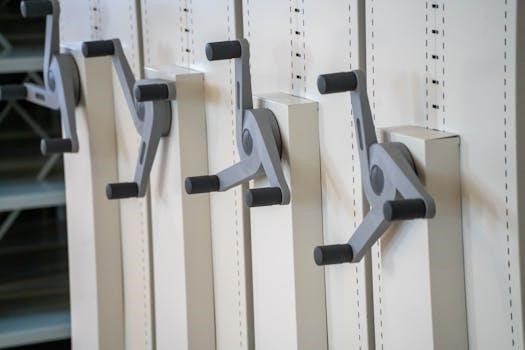A torque wrench is a specialized tool used to apply a specific amount of rotational force‚ or torque‚ to fasteners like nuts and bolts. It ensures proper tightening‚ preventing over or under-tightening‚ and is vital for mechanics and DIYers.
What is a Torque Wrench?
A torque wrench is a precision instrument designed to apply a specific amount of rotational force‚ known as torque‚ to fasteners. Unlike standard wrenches‚ it allows users to control the tightening force‚ preventing damage to components and ensuring proper assembly. Torque wrenches are essential for various applications‚ from automotive repair to machinery maintenance‚ where precise fastening is crucial for safety and performance. They come in mechanical and electronic types‚ each offering unique features for accurate torque application. They are essential for professionals and DIYers alike who seek precision in their projects.

Setting and Adjusting a Torque Wrench
Setting a torque wrench involves adjusting it to the desired torque value. This is done by loosening the locking mechanism and rotating the handle or knob to the correct measurement.
Loosening the Locking Mechanism
Before adjusting a torque wrench‚ it’s essential to loosen the locking mechanism. This usually involves turning a cap or knob located at the handle’s base counterclockwise. This action releases the internal mechanism‚ allowing you to freely adjust the torque setting. Ensure the mechanism is fully disengaged before proceeding to avoid any damage or inaccurate readings. This step is crucial for precise torque application.
Adjusting to the Desired Torque
Once the locking mechanism is loose‚ you can proceed to adjust the torque to your desired setting. Rotate the handle or knob‚ usually clockwise‚ to increase the torque value. Most wrenches have a clear scale indicating the torque in foot-pounds or meters per kilogram. Carefully align the desired torque value with the indicator on the wrench. Make sure the setting is accurate for proper fastening.

Proper Torque Wrench Usage
Correct usage involves initial tightening with other tools‚ followed by final tightening with the torque wrench. This ensures accurate torque application and prevents damage to fasteners or the wrench itself.
Initial Tightening with Other Tools
Before using a torque wrench‚ it’s crucial to initially tighten fasteners with other appropriate tools‚ such as ratchets or standard wrenches. This step ensures that the nut or bolt is snug and properly seated before applying the precise torque. Using a torque wrench for initial tightening can be inaccurate and may cause unnecessary wear on the tool‚ so using other tools for this step is highly recommended.
Final Tightening with Torque Wrench
After initial tightening‚ use the torque wrench for the final tightening to achieve the specified torque. Apply a smooth‚ controlled motion when turning the wrench until the desired torque is reached. It is critical to avoid jerky or rapid movements as they can lead to inaccurate readings. The torque wrench ensures the fastener is tightened to the precise torque‚ preventing damage to the components.
Reading a Torque Wrench
Reading a torque wrench accurately involves understanding the measurement units‚ such as foot-pounds or Newton-meters‚ and correctly interpreting the scale on the wrench to ensure precise torque application.
Understanding Torque Units
Torque‚ the rotational force applied by a wrench‚ is typically measured in foot-pounds (ft-lbs) or Newton-meters (Nm). Foot-pounds are commonly used in the United States‚ while Newton-meters are the standard metric unit. It is crucial to know which unit is required for your specific application and to ensure that your torque wrench is set to the correct unit. Using the wrong unit can result in improper fastening‚ potentially causing damage or safety issues. Understanding these units is essential for accurate torque application.
Safety and Maintenance
Always follow the manufacturer’s instructions carefully to avoid damage‚ injury‚ or property damage. Handle the torque wrench with care‚ and store it properly to maintain its accuracy and extend its lifespan.
Importance of Following Instructions
Adhering to the instructions in the torque wrench manual is crucial for safe and effective use. Failure to do so could result in damage to the tool‚ the workpiece‚ or even personal injury. The manual provides specific guidelines on proper operation‚ torque settings‚ and maintenance procedures. It is essential to read and understand the entire manual before using the tool to ensure accurate and safe application of torque. Ignoring instructions can lead to inaccurate readings‚ over-tightening‚ or under-tightening fasteners‚ compromising the integrity of the assembly.
Proper Handling and Storage
Treating a torque wrench as a precision instrument is vital for its longevity and accuracy. Avoid dropping or subjecting it to impact‚ as this can damage its internal mechanisms. Store it in a clean‚ dry place‚ preferably in its case‚ to prevent dust and moisture accumulation. Always release the tension on the wrench after use. Never use the torque wrench as a regular wrench or for breaking loose fasteners to prevent damage and ensure its proper functioning for future use. This careful handling will maintain its accuracy and extend its lifespan.
Types of Torque Wrenches
Torque wrenches come in various types‚ including mechanical and electronic versions. Mechanical types utilize a click mechanism‚ while electronic ones offer digital readouts and advanced features for precise torque control.
Mechanical Torque Wrenches
Mechanical torque wrenches are a classic design featuring a 3-phase mechanism that provides clear signals‚ often an audible click‚ when the set torque is reached. These wrenches are adjusted manually and are known for their durability and reliability. Britool offers various models of this type. They are often preferred for their simplicity and do not require batteries‚ making them a dependable choice for many applications. They are also generally less expensive than their electronic counterparts.
Electronic Torque Wrenches
Electronic torque wrenches incorporate advanced technology‚ often including an LCD screen to display torque readings. These tools may provide an audible signal‚ vibration‚ and a visual display when the set torque is reached‚ offering precise measurements. Some models feature interchangeable heads and electronic torque value readouts. They also offer different modes of operation and units selection. These wrenches are designed to signal when the target torque or angle has been achieved‚ enhancing accuracy and user experience.

Torque Wrench Applications
Torque wrenches are essential for fastening bolts and nuts to precise specifications‚ ensuring secure and reliable connections. They are also used to check existing torque to maintain integrity and safety.
Fastening Bolts and Nuts
Using a torque wrench ensures bolts and nuts are tightened to the manufacturer’s specified torque. This prevents damage from over-tightening or loosening due to under-tightening. It’s crucial for maintaining the integrity of assemblies. The correct torque ensures fasteners have the proper clamping force‚ preventing joint failure and ensuring optimal performance and safety. Always refer to the specific torque values for each bolt or nut size and material.
Checking Torque Specifications
Torque wrenches are essential for verifying that fasteners are tightened to the correct specification. This is important when working with assemblies that require precise torque values. Using a torque wrench allows you to check the torque on existing fasteners‚ ensuring they haven’t loosened or been over-tightened. Accurate torque is vital for safety and performance in mechanical systems‚ and a torque wrench helps maintain those standards. Always consult manufacturer specifications for the correct torque values.

Torque Wrench Signals
Torque wrenches use signals to indicate when the desired torque is reached. These signals can include an audible click‚ a vibration‚ or a visual display on an LCD screen.
Audible Click Signal
Many mechanical torque wrenches feature an audible click signal. This distinct sound indicates that the preset torque has been achieved. The user should stop applying force to the wrench immediately upon hearing the click to avoid over-tightening. This click mechanism provides a clear and reliable indication‚ making it a user-friendly feature for various applications. The click is a precise signal and should be listened for carefully.
Vibration and LCD Display
Electronic torque wrenches often use both vibration and an LCD display to signal when the target torque is reached. The vibration provides tactile feedback‚ while the LCD screen displays the current torque value. This dual system allows users to monitor the tightening process visually and physically. The combination of these features enhances precision and ensures accurate torque application. This makes these wrenches useful in situations that require visual or tactile confirmation.




